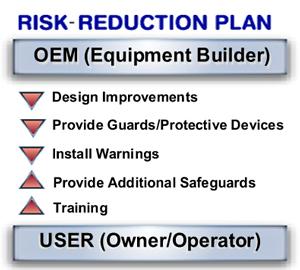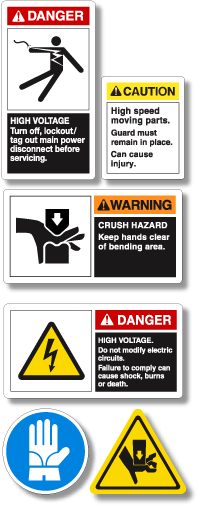Contributing Writer
- FMA
- The Fabricator
- FABTECH
- Canadian Metalworking
Categories
- Additive Manufacturing
- Aluminum Welding
- Arc Welding
- Assembly and Joining
- Automation and Robotics
- Bending and Forming
- Consumables
- Cutting and Weld Prep
- Electric Vehicles
- En Español
- Finishing
- Hydroforming
- Laser Cutting
- Laser Welding
- Machining
- Manufacturing Software
- Materials Handling
- Metals/Materials
- Oxyfuel Cutting
- Plasma Cutting
- Power Tools
- Punching and Other Holemaking
- Roll Forming
- Safety
- Sawing
- Shearing
- Shop Management
- Testing and Measuring
- Tube and Pipe Fabrication
- Tube and Pipe Production
- Waterjet Cutting
Industry Directory
Webcasts
Podcasts
FAB 40
Advertise
Subscribe
Account Login
Search
Last chance: Read the sign!
- By Russ Butchko
- May 22, 2007
- Article
- Safety
Are we thinking of summer vacation yet? Long-distance travel, road trips?
In our preparation check list, we make sure the car has had its routine maintenance; we map out the trip, pack carefully, and fill up the tank.
And when we're on the road, we're mindful of the road signs, especially the ones that say "Last Chance Gas," right? Years ago I was traveling in the Southwest and opted to take a shorter route through the desert. I should have paid more attention to the "last chance" sign.
As owners or operators in the manufacturing industry, we see numerous "last chance" messages relating to the safe operation of shears, presses, formers, welders, and all types of machinery in our shops—all attached to the equipment and machinery we operate. They continuously remind us what to do and what not to do to keep us safe. Not heeding these warnings could have a significantly greater impact than running out of gas.
Importance of the Message
Just like the urgency of the "last chance gas" sign, the strategic location of a warning sign has critical importance too: It's the last reminder we get regarding some aspect of safe operation.
Additionally, despite all the preemptive efforts that we employ— such as providing safety manuals, training, and supervision—human nature is what it is. Take a new automobile for instance. It's a good bet that the average person's first encounter with a warning label or safety alert is at the point of the hazard— for example, under the hood or the LED on the dash—and not the safety manual in the glove compartment.
In the hierarchy of risk reduction, warning signs and safety labeling on equipment are at the midpoint of the priority list. (More information about risk reduction for machinery and equipment is referenced at the end of this article.)
In short, the recommendations are that both the OEM (equipment builder) and the user (equipment operator) take part in the process (Figure 1).
The OEM is working from the top of the chart, designing improvements to minimize hazards and installing guarding to eliminate contact with hazards.
The user is working from the bottom of the chart, training employees in safe operation and providing them with additional protective measures or equipment.
While opportunities exist for the OEM and the user to help each other, control and capability issues often cause responsibilities to divide at the midpoint, which is usually the location of the hazard. Hopefully, it will have a warning sign, the last chance message that says "You're going to run out of gas!"
What Should the Message Look Like?
Safety communication and labeling have come a long way from the days of the old "Keep Out," "Keep Off," and "Think" signage. Though these older versions, which were originally Occupational Safety and Health Administration (OSHA) signage, still exist, the preferred formats are those suggested by the American National Standards Institute (ANSI) and the International Standards Organization (ISO). These new formats, set up primarily for product identification, are working their way into environmental signage as well, because of their preferred communication abilities.
In particular, the ANSI-Z535 Committee on Safety Signs and Colors has produced standards for all manufacturers to use that are highly effective in the design of safety messaging. Elements of design in these standards are format or layout, use of "signal" words, colors, graphic safety symbols, and written-word messages. Examples of more common versions are shown in( Figure 2) along with a similar ISO version.
To determine the final design of the warning label, an OEM will conduct a survey of its products and then follow a prescribed procedure for the development process. This can be accomplished through an in-house engineering staff or, more frequently, through a consultant/producer of safety identification.
Application to FMA Members
The large variety of products, machines, and equipment in the manufacturing environment usually requires individual interpretation and design of hazard notifications. Each machine has a different type of hazard, operational standard, opportunity, and audience.
One successful approach is to use the available national standards and apply them in the design of industry-specific safety identification. In this way, similar manufacturers or trade associations can benefit from continuity of presentation and other advantages, including:
- Relativity. Members are able to draw from standard messages to meet the industry-specific needs of their equipment, instead of searching through multiple sources or developing their own.
- Comprehensibility. Particular attention is given to developing messages that are understood and meaningful to a specific audience.
- Safety. Standardized presentation of safety messages promotes familiarity, safer operation, and better individual protection through participation in industrywide guidelines.
- Economy. Standardization produces economies of scale.
Good News
In general, OEMs and users alike are employing all of their resources to improve and safeguard their equipment. Safe design and guarding against potential hazards are normally part of the thought process. And when necessary, better safety warning and labeling can prevent more injuries at the hazard point, the "last chance."
Your Safety Council — a group of volunteer FMA members — is in the process of assisting in this area. In the meantime, here are some resources for applicable standards:
ANSI-Z535.1,2,3,4,5 www.nema.orgorwww.webstore.ansi.org
ANSI B11.TR3-2000 www.webstore.ansi.org
ISO 1184 www.iso.org
FMA Safety Council http://fmanet.org/technology-councils/safety-council
About the Author
Russ Butchko
P.O. Box 487
North Olmsted, OH 44070
440-777-6660
subscribe now

The Fabricator is North America's leading magazine for the metal forming and fabricating industry. The magazine delivers the news, technical articles, and case histories that enable fabricators to do their jobs more efficiently. The Fabricator has served the industry since 1970.
start your free subscription- Stay connected from anywhere

Easily access valuable industry resources now with full access to the digital edition of The Fabricator.

Easily access valuable industry resources now with full access to the digital edition of The Welder.

Easily access valuable industry resources now with full access to the digital edition of The Tube and Pipe Journal.
- Podcasting
- Podcast:
- The Fabricator Podcast
- Published:
- 04/16/2024
- Running Time:
- 63:29
In this episode of The Fabricator Podcast, Caleb Chamberlain, co-founder and CEO of OSH Cut, discusses his company’s...
- Trending Articles
Tips for creating sheet metal tubes with perforations

Are two heads better than one in fiber laser cutting?

Supporting the metal fabricating industry through FMA

JM Steel triples capacity for solar energy projects at Pennsylvania facility

Omco Solar opens second Alabama manufacturing facility

- Industry Events
16th Annual Safety Conference
- April 30 - May 1, 2024
- Elgin,
Pipe and Tube Conference
- May 21 - 22, 2024
- Omaha, NE
World-Class Roll Forming Workshop
- June 5 - 6, 2024
- Louisville, KY
Advanced Laser Application Workshop
- June 25 - 27, 2024
- Novi, MI




























